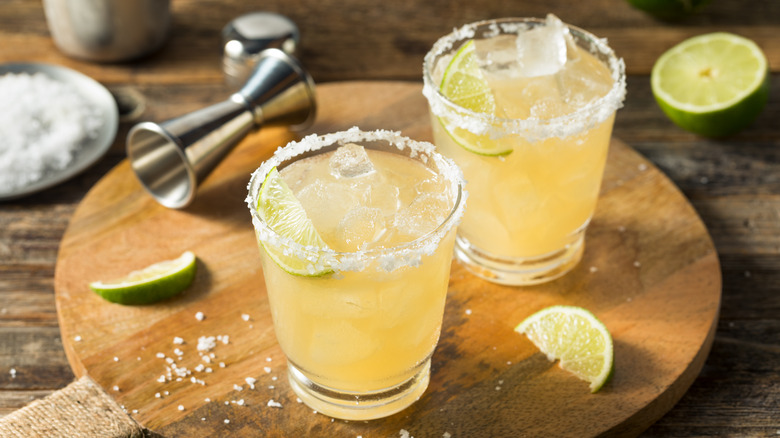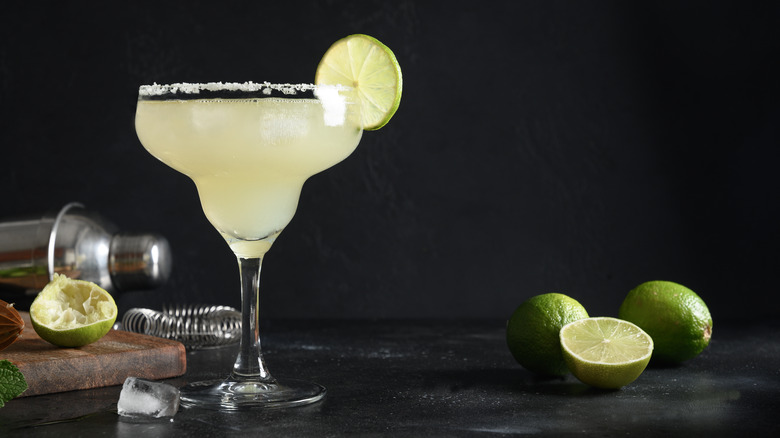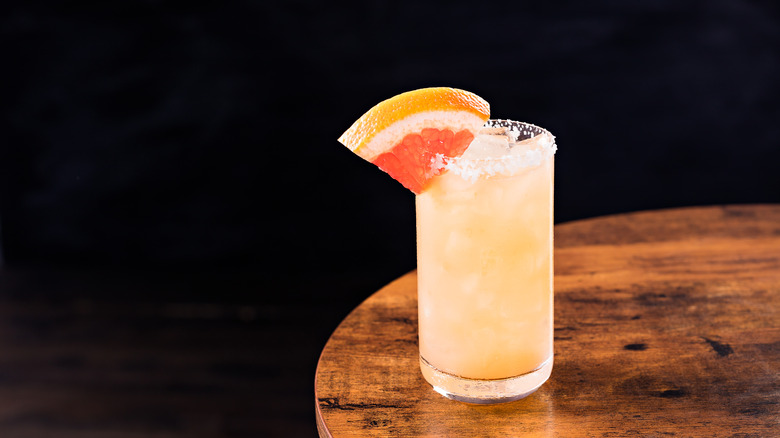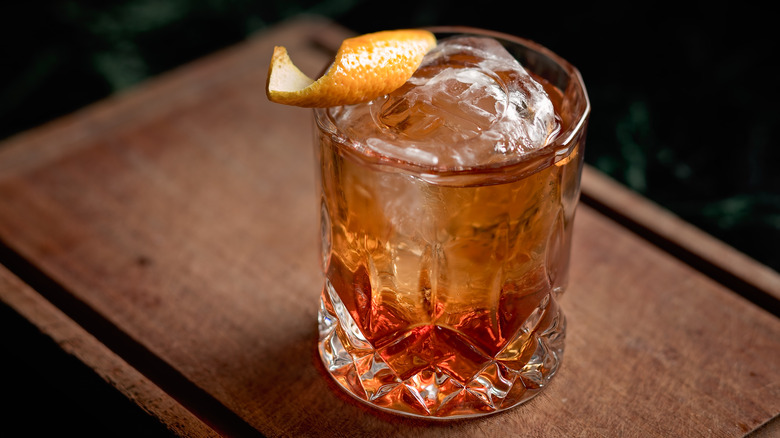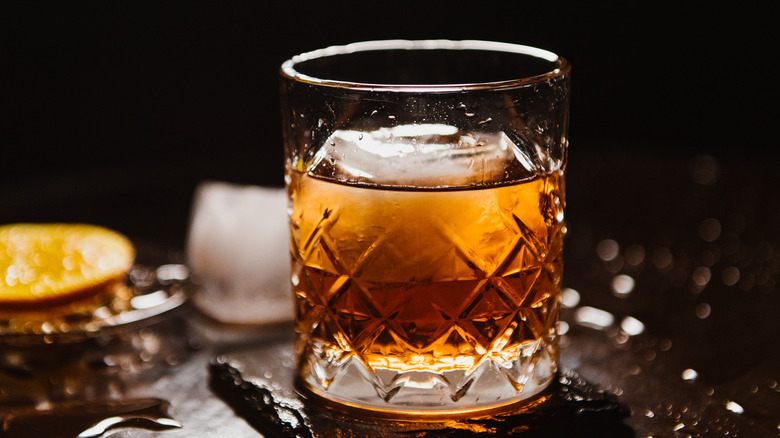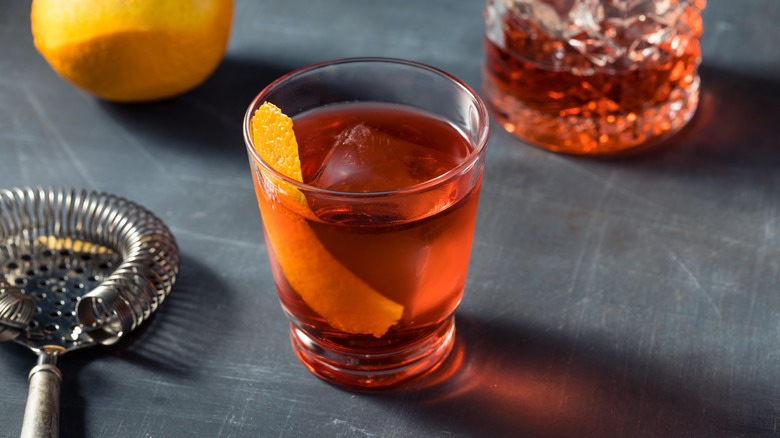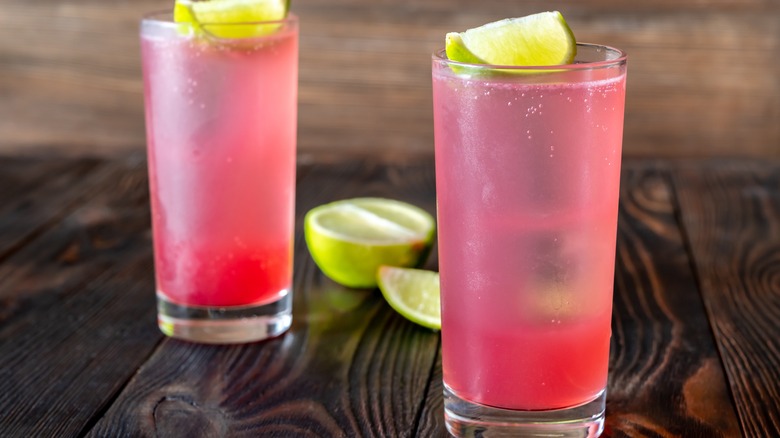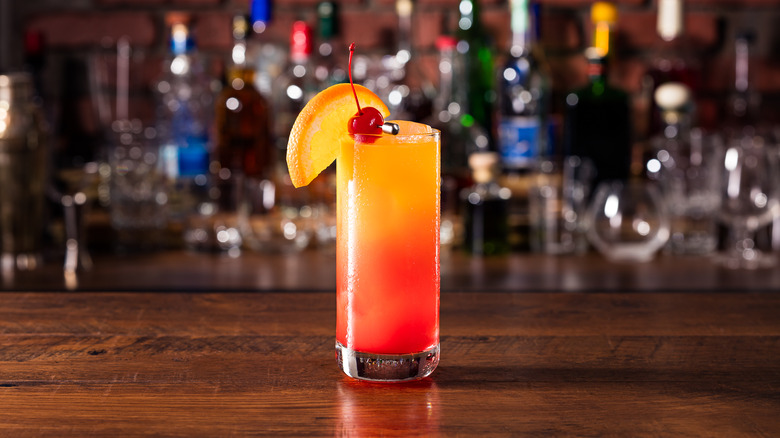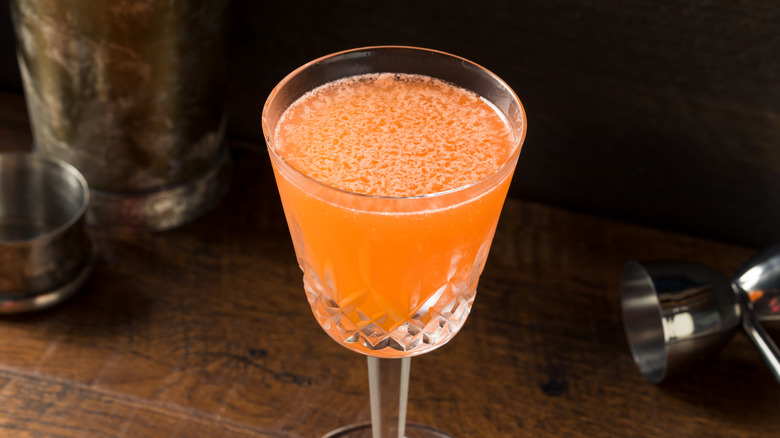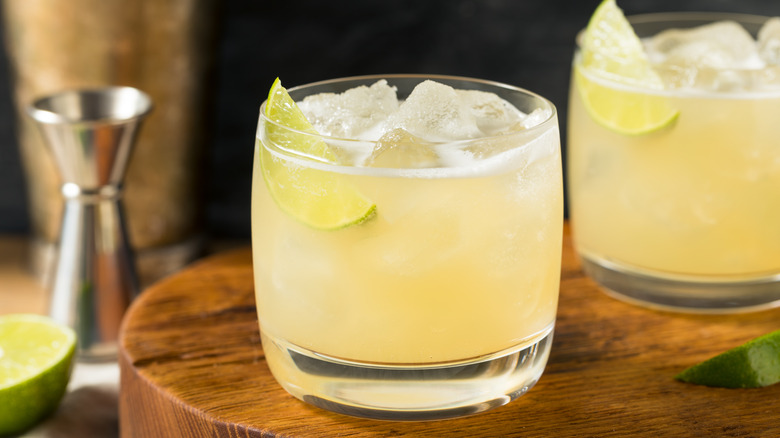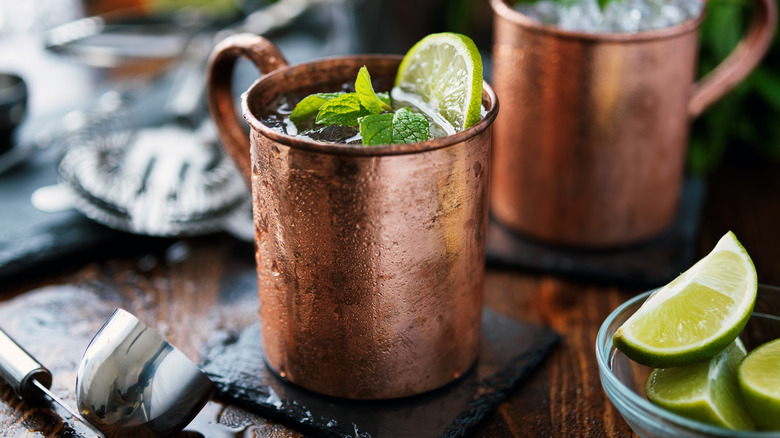The 10 Best Tequila And Mezcal Cocktails
Tequila and mezcal are currently undergoing something of a phenomenon. We're long past the days when tequila was merely regarded as a cheap party shooter, while its smoky cousin is finally getting the attention, respect, and sales it deserves. According to IWSR, in 2020 the combined U.S. sales of the agave-based spirits surpassed that of both rum and bourbon.
There is no doubt that the Mexican imports are taking over the spirits world, but what's actually the difference between tequila and mezcal? Well, both spirits are made from agave, but, legally, tequila can only be made from the blue weber agave species, whereas mezcal can be made from dozens. There are also production methods that differ, most notably, how the agave is cooked. Instead of being cooked inside an oven, the agave used for mezcal is cooked in an earthen pit covered with rocks, wood, and leaves. This infuses the agave piñas with a rich smokiness, which is what makes the spirit so unique and complex.
Throughout cocktail history, there have been a handful of classic tequila cocktails, and even fewer that featured mezcal. But now that tequila and mezcal are firmly embedded in cocktail culture, a variety of libations featuring the spirits are considered modern standards. The following includes a combination of all-time hits and breakthrough stars, perfect for those unfamiliar with the spirits as well as seasoned veterans.
Margarita
Cocktail trends may come and go but the margarita is here to stay. This classic is believed to have first been shaken up in the 1930s, though the first margarita was known by another name (via Difford's Guide). Back then, there was a popular category of cocktails called the daisy. Daisy cocktails consisted of a base spirit, citrus juice, and syrup or liqueur to sweeten the drink. The name "margarita," translates to "daisy," in Spanish, which is where the name comes from.
Daisy cocktails date back to the Victorian era, but it was 1936 when the tequila daisy was first mentioned in a newspaper called Moville Mail. From there, recipes were published under multiple names such as the Picador and Tequila Sour. It was not until 1953 in The Press Democrat that the cocktail appeared in writing under the name "margarita."
The classic margarita, which combines tequila, lime juice, and orange liqueur such as Cointreau or triple sec, continues to be nothing short of a staple drink, always reliable, always refreshing, and always delicious. However, it is all too common that a pre-made mix is used to prepare the drink. Considering the cocktail is made up of only three components, scratch made with fresh lime juice is always preferred.
Paloma
The Paloma is a super bright and quaffable cocktail, but its origins are quite murky. It is widely regarded that the recipe for the drink was first published in a pamphlet called "Popular Drinks of the Rio Grande" by Evan Harrison in 1953 (via Alcademics). However, the invention of the cocktail is often credited to Manuel Gonzales, a tavern manager in Mexico, who is said to have named the drink after his true love. Apparently, Harrison and Gonzales were bitter rivals in the bar business and when Harrison stole Gonzales's lover from him, he published the cocktail to add insult to injury.
It turns out the somewhat dim history behind the Paloma is quite the opposite of the cocktail, itself. Consider it the margarita's more eccentric, bubbly cousin, made up of tequila, lime juice, sugar, and a topping of grapefruit soda (Squirt and Jarritos are popular options). You can also prepare it with a squeeze of fresh grapefruit juice and top everything off with club soda. The former is a lower maintenance, sweeter option and most likely what you will receive if you order a Paloma at a bar or restaurant. The latter, on the other hand, makes a more complex, balanced drink. The fresh grapefruit is super vibrant and crisp and the perfect complement to the lime and sugar. If agave spirit of choice happens to be mezcal, feel free to use that as your base instead of tequila.
Añejo old fashioned
The old fashioned is a cocktail classic that remains a go-to drink over a century after its creation. The first form of the Old Fashioned came about in 1880 when bourbon connoisseur, James E. Pepper, ordered a cocktail made in "the old fashioned way" while imbibing in a Louisville bar. The request was in reference to recipes in "Jerry Thomas' Bartender's Guide: How to Mix Drinks," published 18 years prior. These drinks consisted of a spirit, a lump of sugar, water, bitters, and a citrus peel. From then on, the old fashioned has sustained as such, more or less unchanged since.
The beauty of the old fashioned is it can be made using whatever spirit you like. While whiskey (often bourbon) is the standard, an añejo tequila is a wonderfully nuanced option. There are multiple types pf tequila, including blanco, reposado, añejo, and extra añejo. Blanco tequila is the most basic, bottled, and distributed shortly after its distillation. Reposados, which means "rested," are tequilas that are aged in oak barrels for several months, accumulating flavor and texture over time. Añejo tequilas, which are aged for a minimum of one full year, take on a fuller character, ripe with notes of vanilla, caramel, and oak, reminiscent of whiskey, but these all work in harmony with the agave, in this case. A swap of agave syrup for sugar enhances this complimentary parity even further, making for a simple, yet decadent take on the classic cocktail.
Oaxaca old fashioned
This old fashioned variation utilizes tequila as well as mezcal. The Oaxaca old fashioned is one of the most popular drinks to be born out of the current cocktail boom. The cocktail is courtesy of Phil Ward, bartender at the legendary Death and Co. in New York City. It was first mixed in 2007 during a time when mezcal was a widely misunderstood and underused spirit.
The combination of 1½ ounces of reposado tequila, ½ ounce of mezcal, Angostura bitters, and agave nectar turned the straightforward and familiar cocktail into something with immense depth and complexity with layers upon layers of absolute delight. The barrel notes of the reposado combined with the smokiness of the mezcal are a match made in heaven. The bitters provide that iconic spice you know and love in an Old Fashioned while the agave keeps the spirit's foundation strong and potent.
It's no surprise that the Oaxaca old fashioned quickly became a Death and Co. signature. Now imitated all across the globe, the cocktail helped usher in a wave of mezcal libations. If you are able to get your hands on a bottle of reposado and mezcal to mix this up yourself, do not hesitate. If not, ordering one at a cocktail bar will most likely be followed by a nod of approval from the bartender.
Mezcal Negroni
The Negroni has inspired countless riffs since its creation in 1919. Simple substitutions such as bourbon for gin, dry vermouth for sweet, and another bitter aperitivo for Campari can turn this equal parts template into something new and exciting with ease. The Mezcal Negroni, however, is one variation of the classic Italian cocktail that has become one of the biggest hits of the 21st century.
The invention of the Mezcal Negroni is not credited to any single bartender, but more to the experimentative and resourceful nature of the modern cocktail era, according to Punch. As drinks such as the Oaxaca Old Fashioned became more and more popular, the use of mezcal saw a rise in its employment. Simultaneously, classics like the Negroni, which had been ever common for decades abroad, grew more prominent in the U.S. It was only a matter of time before mezcal would be tapped to play the role of gin and take the Negroni to new heights.
Not only are the herbaceous notes of the vermouth complimented by the smoke and earthiness of the mezcal, but the sweetness from the agave also functions with the vermouth to combat the bitterness of the Campari. The classic Negroni is undoubtedly a dry, more bitter cocktail, but the mezcal tones everything down while also packing a punch. That same supreme balance and potency are achieved while also making for a more approachable drink.
El Diablo
The El Diablo is a throwback cocktail credited to the tiki-chain legend Trader Vic's. Victor Bergeron, the chain's owner, included a recipe for the cocktail in his cocktail manual in 1946 and on his menus in 1947 (via VinePair). Though the drink's initial popularity was short-lived, it's recently returned to heavy rotation. In recent years, the El Diablo has seen quite the comeback and is more popular today than ever before, becoming a fan-favorite at bars (tiki and otherwise) all around the globe. In 2021, Drinks International ranked it as the world's 46th best-selling classic cocktail.
The El Diablo is a combination of reposado tequila, lime juice, creme de cassis (black currant liqueur), and a topping of ginger beer. Essentially, this drink is a Mexican Mule with the addition of creme de cassis, but a mere ½ ounce of it goes a long, delicious way. The sweet liqueur offers fruity and herbaceous notes and serves as the perfect balancing act to the lime juice and tequila. The ginger beer addition not only provides some bright effervescence, but the spice of the soda also adds another layer of flavor to complement the other three ingredients. The El Diablo is a simple yet spectacular drink and its return to the limelight is more than well deserved.
Tequila Sunrise
This drink is another all-time classic known for its simplicity and being an easy-sipper, but the Tequila Sunrise we know today that exploded in popularity in the 1970s underwent a great transformation from its original form. The initial recipe for this tequila drink came about in the 1930s and is credited to Gene Sulit, who obliged a customer's request for a tequila drink refreshing enough for the pool per The Phoenix New Times. The original recipe calls for a combination of tequila, creme de cassis, lime juice, and a topping of soda water.
The Tequila Sunrise recognized and mixed by drinkers and bartenders today is the iconic three-ingredient cocktail consisting of tequila, grenadine, and orange juice. This contemporary version became popularized by none other than the Rolling Stones. According to The Daily Beast, the band was brought to the Trident restaurant for drinks to relax after the infamous and fatal Hell Angels incident in 1972. The restaurant was keen on tequila, using the spirit for twists on classic cocktails. The bartender, Bobby Lozzoff, reimagined the original Tequila Sunrise with orange juice and grenadine. The Stones fell in love and had their manager add the ingredients to their official rider so they could make it for themselves backstage.
The Tequila Sunrise is not the most complex drink, but its components of sweetness, tartness, and booze do make for a crushable cocktail. Plus, the gradient effect of the grenadine sinking to the bottom of the glass provides aesthetic appeal.
Division Bell
The Division Bell is another mezcal cocktail courtesy of Phil Ward, creator of the Oaxaca Old Fashioned. Ward came up with the drink in 2009 for the opening of Mayahuel, a mezcal-centric cocktail bar in New York's East Village (via The Educated Barfly).
The recipe, which features mezcal, Aperol, maraschino liqueur, and lime juice, is a riff on the classic Last Word, although the Division Bell does not adhere to the same equal-parts cocktail template. Instead, the mezcal takes center stage with a full ounces measurement, the Aperol and lime juice are in support with ¾-ounce measurements each, and a ½ ounce of maraschino liqueur rounds everything out.
While the Division Bell is similar to the Last Word in concept, it differs in execution. Gin is replaced with mezcal, the green chartreuse with Aperol, and the measurements are adjusted accordingly. If the Division Bell were to be made in an equal-parts fashion, it would not be balanced. Not only would the mezcal be lost, but the maraschino liqueur would end up dominating the more delicate Aperol and lime juice. In this refined form, the Division Bell is exceptionally balanced, with the Aperol's slight bittersweetness countered by the dryness of the maraschino liqueur. The lime juice and agave in the mezcal are natural companions, and the mezcal's smoke is the undertone of it all. This one is simply a must-try.
Tommy's Margarita
Like many classic cocktails, one simple adjustment can turn it into something unique and completely its own thing. That is the case with Tommy's Margarita. This margarita variation simply swaps outs the orange liqueur for agave nectar, an ingredient that is common now but quite rare when the drink was created.
Tommy's Margarita was invented by Julio Bermejo, bar manager at Tommy's Mexican Restaurant in San Francisco, per Curatif. The restaurant was opened by Bermejo's parents back in 1965, and Julio finally struck gold with this cocktail to commemorate the family business in the late 1980s. One day, Bermejo encountered what, to him, was a new phrase on tequila bottle labels, "100% blue agave." This new discovery led him to visit Mexico and reinvent his understanding of the spirit, returning to transform his restaurant into an extensive tequila bar.
During that same time, Bermejo was introduced to agave nectar and was able to track down the ingredient in a health food store. He began using the sweet addition in his margaritas, and the recipe ended up sticking both at his bar and beyond. The agave nectar is a natural sweetener that enhances the flavor of the tequila, making for a more spirit-forward margarita that places an emphasis on the tequila itself with nothing to hide any lack in quality. The margarita is already as basic as cocktails come, and Tommy's Margarita takes this simplicity even further in the best way possible.
Mezcal Mule
Everyone loves a mule. This three-ingredient combination of spirit, lime juice, and ginger beer served in that iconic copper mug is always a direct hit. The strange reason the Moscow Mule was invented almost seems too coincidental to be true. Sophia Berezinski had recently immigrated to America from Russia in 1941 with a surplus of mugs from her father's copper factory. As she struggled to sell them, she entered a bar and met two gentlemen facing similar problems. One, John Martin, had just acquired the Smirnoff vodka distillery and realized the spirit had yet to hit its stride in America. The pub owner, Jack Morgan, was trying to get his own brand of ginger beer up and running. The entrepreneurs saw what was right in front of them and they came up with a cocktail that remedied all three problems.
Nowadays, there are all sorts of variations on the cocktail including the gin-based London Mule, the Kentucky Mule, which features bourbon, and the list goes on. The Mezcal Mule, however, is one of the more recent iterations of the classic drink and should be the next one you try. Of course, all mules are tasty, but there is just something about the combination of the spicy ginger beer and the smoky mezcal that just elevates it to different heights. The Mezcal Mule is reason enough to get a bottle of the spirit if it's not already part of your bar collection.
